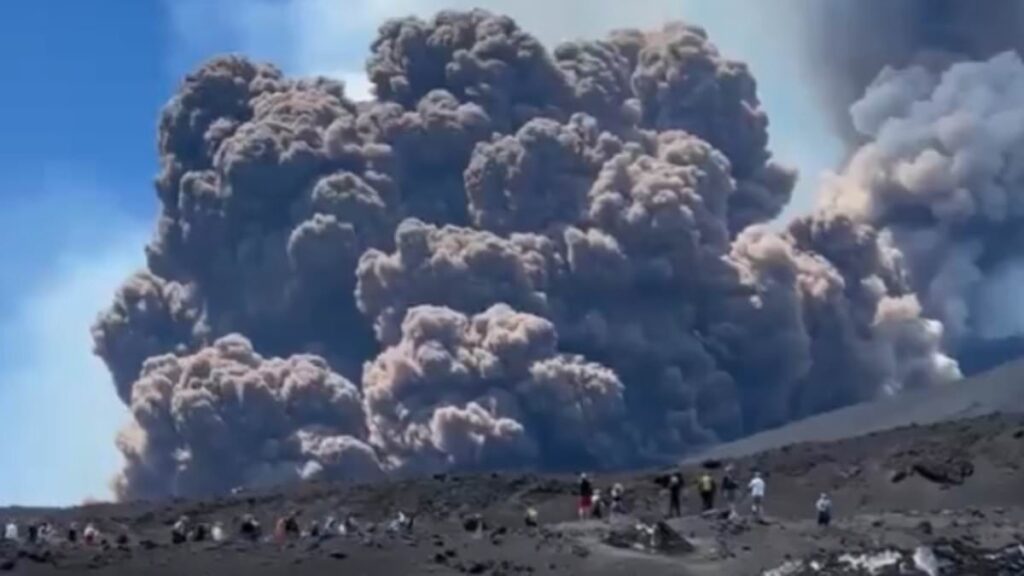Huge clouds of ash have exploded from Mount Etna, triggered by an avalanche of boiling rock hurtling down the side of the volcano.
Tourists visiting the Italian volcano were forced to run for their lives after a ginormous ash cloud erupted behind them.
Residents in nearby towns and cities could see the dramatic cloud begin to dominate the skyline, with ash beginning to settle on buildings and roads.
Keen seismologists were stopping on the way down the gravelly slopes to turn back and snap a quick pic of the terrifying clouds.
In one video, the monstrous formation begins to blot out the sun.
Tourists are able to visit the 3,300m-high Mount Etna in guided tours or access certain areas independently.
A red aviation warning was briefly issued by the Volcanic Ash Advisory Centre Toulouse but has now turned to orange.
The most active volcano in Europe had been experiencing some activity in the last few hours with volcanic tremors felt overnight but has escalated to continuous ‘explosions of growing intensity’.
In shocking footage seen online, dozens of holidaymakers began running along a ledge of the volcano, with the ginormous ash cloud growing behind them
Huge plumes of ash were seen spewed out of the most active volcano in Europe
Users on social media have been sharing footage of the horrifying ash cloud that is threatening to cover the Italian island
The pyroclastic flow – an avalanche of burning ash careening down the slopes at a fast-pace and high-density – does not appear to have passed the edge of the Valley of the Lion, one of Etna’s slopes.
The National Institute of Geophysics and Volcanology, Etnean Observatory, said the pyroclastic flow was ‘probably produced by a collapse of material from the northern flank of the South-East Crater’.
A ‘lava fountain’ has also begun after the ash bomb, according to the institute.
The ominous ash cloud is said to mainly consist of water and sulfur dioxide and was ‘drifting towards the south west’
The National Institute of Geophysics and Volcanology said earlier this morning: ‘Over the past few hours, the activity flagged in the previous statement issued at 4.14am (3.14am BST) has carried on with strombolian explosions of growing intensity that, at the moment, are of strong intensity and nearly continuous.
‘Over the past few hours, the falling of a little thin ash has been flagged in the Piano Vetore area.’
The terrifying volcanic tremor began just after 10pm last night, reaching its peak three hours later at about 2.8km below the crater.
A livestream of the volcano captured the terrifying moment and users can watch the cloud descend over the island.
Terrifying clouds of ash more than a mile high erupted from Mount Etna this morning
The ominous ash cloud is said to mainly consist of water and sulfur dioxide and was ‘drifting towards the south west
Huge plumes fo ash were seen spewing out of Mount Etna from Catania early this morning
Your browser does not support iframes.
Smoke rises from the crater of the Etna volcano as it erupts
In one video, the monstrous formation begins to blot out the sun
Crowds look on in shock as a ginormous ash cloud begins to cover the city of Catania
Volcanic steam rises from Mount Etna, near Motta Camastra, Sicily, Italy
Activity has calmed in the last hour but the threatening grey cloud is still visible.
Mount Etna, located on the eastern coast of Sicily, is one of the most active volcanoes worldwide and has been going through an especially active period for the last five years.
Last summer, the volcano caused chaos at nearby airports as they were forced to limit and divert flights as pilots struggled with visibility.
A usually busy Catania airport had to send flights to other airports on the island, such as Palermo and Comiso.
Arriving flights were reduced to six per hour and one section of the airport was closed, while local towns were also covered in a blanket of black ash.
The 500,000-year-old volcano has been spewing lava during repeated outbursts in May before today’s explosion.
Etna’s most destructive eruption covered 14 villages and towns in lava flows and earthquakes from the volcano.
The eruption, which lasted several weeks, killed nearly 20,000 people, with thousands more made homeless, according to records from 1669.
